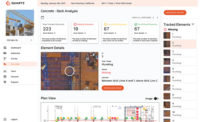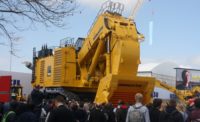A simple request from the University of Wisconsin-Madison for the construction of its 102,000-sq-ft, $27.5-million La Bahn Arena presented an engineering challenge for the contractor.
"They wanted as much open space as they could get in the men's and women's hockey locker rooms," says Dave Beck-Engel, executive vice president, J.H. Findorff & Son, the project's principal contractor. "But with a traditional concrete slab, it got pretty thick, [and the] low ceilings got in the way."
After considering its options, the project team chose to use BubbleDeck, a nontraditional concrete slab system which uses evenly spaced plastic bubbles to reduce the amount of concrete in the slab. The voids in BubbleDeck can result in up to 30% less concrete usage compared to a typical poured slab.
La Bahn Arena is the first use of BubbleDeck in the U.S. "We were studying BubbleDeck for a while," says Dan Windorski, a structural engineer with GRAEF, the engineer-of-record for the project, and a consultant with BubbleDeck North America. "It's been used extensively in Europe and Canada but not the U.S., and we thought this would be a perfect application for it."
The plastic balls and the prefabricated steel cages can be assembled on-site, but most customers choose to have them delivered in place on a precast concrete panel to save time, says Jerry Clarke-Ames, BubbleDeck North America president. "Using the precast panels takes away the need for any formwork and allows us to work with mechanical-electrical-plumbing contractors to install sleeves and conduit," he says. "We can achieve install times similar to steel."
In August, crews placed 13,000 sq ft of BubbleDeck panels at the arena, where some spans approach 40 ft. "We had to get in and out of the ground quickly," says Windorski. "The work area was also the access to the adjacent Kohl Center [sports arena] and was a priority. A lot of it is prefab off-the-shelf, so they could get it in pretty darn quick. Eighty percent of the steel comes pre-tied, which is great for inspections."
BubbleDeck is not for every project. "This project was a good fit for BubbleDeck … but it's not appropriate for every situation," says Tom Sweeny, preconstruction specialist, Findorff. "In a traditional 8-in. to 10-in. slab, it's about 10% to 15% less concrete [with BubbleDeck]. But as the cost of concrete goes up, it becomes more viable." According to Findorff, using BubbleDeck on the project saved the owner about $25,000.
Sustainability and stringent environmental regulations are a major factor for BubbleDeck's relative success in Europe. "Using less concrete makes this a green product," says BubbleDeck's Clarke-Ames. "The industry here has caught up to LEED standards, and we need new targets to achieve greater things. There really should be credits on a sliding scale for reducing usage of concrete."
La Bahn Arena is expected to achieve a LEED Silver rating once it is completed in October 2012, but Windorski was just glad to contribute to the greener design.
"Structural engineers have not been able to bring a lot to the table in sustainability. We add a little fly ash to concrete, and I don't think you can even buy non-recycled steel today, so there are not many options," Windorski says. "BubbleDeck can make a building more sustainable in a multistory application by reducing the amount of concrete. It is an opportunity as a structural engineer to make a more sustainable building."







Post a comment to this article
Report Abusive Comment